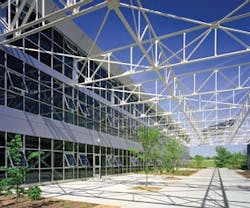Get Your Piping in the Groove
What do the world’s tallest building (the Burj Khalifa in Dubai), the Hoover Dam, and the new Cowboys Stadium have in common? Besides being notable structures, they all make use of grooved piping instead of welded piping.
Grooved piping systems have been used for more than 85 years, and their list of benefits continues to impress. If you’re not aware of the savings that grooved piping can bring, check out how it’s different from welded piping.
How it Works
In grooved piping systems, according to Erick Bacher, engineering specialist at Victaulic, the joint is comprised of a pipe groove (rolled or cut into the pipe), the coupling housings and nuts and bolts, and the pressure-sensitive gasket (fully closed by the couplings). "This design reduces maintenance because it accommodates vibration within the system without periodic product repair or replacement," he says.
The Differences
Obviously, the biggest difference between grooved and welded piping is the use of flame. Grooved piping doesn’t use a flame; welded piping needs a flame to secure the joint. Because of this, Bacher indicates that, in some cases, grooved piping can install up to 10 times faster than welded systems. Grooved systems do have higher material costs than traditional welded systems, however, so they’re more expensive upfront.
The lack of welding is clearly safer for workers and those who occupy the building, but there’s also an environmental component: arc welding consumes energy and specialty gases. The byproducts of this combustion are released as pollutants into the atmosphere.
As mentioned above, grooved couplings reduce stress through the piping system (the gasket and housing reduce vibration). Traditional welded systems accommodate these vibrations, too (via rubber bellows or a braided flexible hose), but Bacher indicates that they may wear out and can be expensive to replace.
With a union at every joint, grooved piping permits access to systems for easy expansion and repair. You just loosen the nuts and drop the section out – you don’t need a torch, a saw, etc. This is handy when the building needs to stay occupied during a fix or expansion. (With the way welded systems are set up, they basically close off the system, making entry more difficult than loosening a nut.)
Once the piping has been installed, verification of a quality installation is quick with grooved systems – they utilize a visual inspection to confirm correct installation, says Bacher. Welded systems use x-rays or ultrasounds to validate a safe joint after installation.
Grooved piping also has the ability to resist seismic movements.
Where it Works
This type of piping system can be used almost anywhere, in any kind of building application. In some high-pressure applications, such as steam plants, welding is required – grooved piping can’t be used in those situations.
Leah B. Garris ([email protected]) is managing editor of BUILDINGS.
